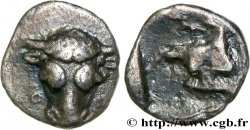- Accueil
- >
- >
无库存.
所有在网站上销售的产品 (2022)
价格 : 120.00 €
所有在网站上销售的产品 (2022)
价格 : 120.00 €
种类 Médaille, Restauration du trône d’Espagne
日期: 1823
铸币厂名称/城市 Espagne
材质 bronze
直径 50,5 mm
模子方针 12 h.
硬币制模工 GAYRARD Raymond (1777-1858)
重量 64,93 g.
侧面 lisse
印模 sans poinçon
关于品相的说明
Patine marron. Petites rayures dans les champs
出版目录中的项代码 :
正面
正面的文字 LVDOVICVS. XVIII. FRANC. ET. NAV. REX..
正面的说明书 Tête de Louis XVIII à droite, signé : GAYRARD F..
背面
背面的文字 ARMIS GALLIAE - VIRTUTE DUCIS // A FURORE REBELLIONIS/ HISPANIA LIBERATA.
背面的说明书 Guerrier debout vêtu à l'antique brandissant le glaive, le bouclier timbré de trois lys, repoussant l'ennemi vers la mer ; à gauche, l'Espagne assise retenant deux enfants, à ses pieds un bouclier timbré aux armes de Castille et de Léon, signé : GAYRARD F..
评论
Paul Joseph Raymond Gayrard, dit Raymond Gayrard, né le 3 septembre 1807 à Clermont-Ferrand (Puy-de-Dôme) et mort en 1855 à Enghien-les-Bains (Val-d'Oise), est un sculpteur et graveur-médailleur français.
Raymond Gayrard étudie à un âge précoce avec son père Raymond Gayrard, sculpteur-graveur, (Rodez, 25 octobre 1777-1858)1. Il est l'élève de François Rude et David d'Angers. Il expose au salon de Paris en 1827 et poursuit ses expositions sa vie durant. En 1834 il obtient la deuxième place au concours et la médaille de première classe en 1846 et 1848. Il expose pour la dernière fois en 1855. Apprécié de la haute société française, il exécute beaucoup de bustes de personnalités contemporaines. Il est est également sculpteur animalier.
La restauration absolutiste en Espagne est la période de l'histoire d'Espagne s'étendant entre 1814 et 1833, au cours de laquelle le pays connaît un rétablissement de la monarchie absolue des Bourbons.
Après la guerre d'indépendance contre l'occupant français, les Cortès se réunissent à Madrid en octobre 1813. Peu après, Napoléon reconnaît Ferdinand VII comme roi d'Espagne par le traité de Valençay. Fort du soutien de la majeure partie de la population espagnole, celui-ci rentre dans sa capitale, le 22 mars 1814, par le chemin de Valence. Il reçoit alors, de la main d'un groupe de fidèles de la monarchie, le manifeste des Perses, une déclaration favorable à une restauration absolutiste.
Début 1823, la Sainte Alliance décide d'intervenir en Espagne, ainsi qu'elle l'a déjà fait à Naples et au Piémont. Le 22 janvier un traité secret est signé qui permet à la France d'envahir l'Espagne pour rétablir Ferdinand VII en monarque absolu..
Paul Joseph Raymond Gayrard, known as Raymond Gayrard, born on September 3, 1807 in Clermont-Ferrand (Puy-de-Dôme) and died in 1855 in Enghien-les-Bains (Val-d'Oise), was a French sculptor and engraver-medalist.
Raymond Gayrard studied at an early age with his father Raymond Gayrard, sculptor-engraver, (Rodez, October 25, 1777-1858)1. He was a student of François Rude and David d'Angers.. He exhibited at the Paris Salon in 1827 and continued to exhibit throughout his life.. In 1834 he obtained second place in the competition and the first class medal in 1846 and 1848.. He exhibited for the last time in 1855. Appreciated by French high society, he executed many busts of contemporary personalities. He is also an animal sculptor.
The Absolutist Restoration in Spain was the period in Spanish history between 1814 and 1833, during which the country experienced a reestablishment of the absolute Bourbon monarchy..
After the war of independence against the French occupiers, the Cortes met in Madrid in October 1813.. Shortly after, Napoleon recognized Ferdinand VII as King of Spain by the Treaty of Valençay. With the support of the majority of the Spanish population, he returned to his capital on March 22, 1814, via Valencia.. He then received, from the hand of a group of loyalists of the monarchy, the manifesto of the Persians, a declaration in favor of an absolutist restoration.
At the beginning of 1823, the Holy Alliance decided to intervene in Spain, as it had already done in Naples and Piedmont.. On January 22, a secret treaty was signed that allowed France to invade Spain and reinstate Ferdinand VII as absolute monarch..
Raymond Gayrard étudie à un âge précoce avec son père Raymond Gayrard, sculpteur-graveur, (Rodez, 25 octobre 1777-1858)1. Il est l'élève de François Rude et David d'Angers. Il expose au salon de Paris en 1827 et poursuit ses expositions sa vie durant. En 1834 il obtient la deuxième place au concours et la médaille de première classe en 1846 et 1848. Il expose pour la dernière fois en 1855. Apprécié de la haute société française, il exécute beaucoup de bustes de personnalités contemporaines. Il est est également sculpteur animalier.
La restauration absolutiste en Espagne est la période de l'histoire d'Espagne s'étendant entre 1814 et 1833, au cours de laquelle le pays connaît un rétablissement de la monarchie absolue des Bourbons.
Après la guerre d'indépendance contre l'occupant français, les Cortès se réunissent à Madrid en octobre 1813. Peu après, Napoléon reconnaît Ferdinand VII comme roi d'Espagne par le traité de Valençay. Fort du soutien de la majeure partie de la population espagnole, celui-ci rentre dans sa capitale, le 22 mars 1814, par le chemin de Valence. Il reçoit alors, de la main d'un groupe de fidèles de la monarchie, le manifeste des Perses, une déclaration favorable à une restauration absolutiste.
Début 1823, la Sainte Alliance décide d'intervenir en Espagne, ainsi qu'elle l'a déjà fait à Naples et au Piémont. Le 22 janvier un traité secret est signé qui permet à la France d'envahir l'Espagne pour rétablir Ferdinand VII en monarque absolu..
Paul Joseph Raymond Gayrard, known as Raymond Gayrard, born on September 3, 1807 in Clermont-Ferrand (Puy-de-Dôme) and died in 1855 in Enghien-les-Bains (Val-d'Oise), was a French sculptor and engraver-medalist.
Raymond Gayrard studied at an early age with his father Raymond Gayrard, sculptor-engraver, (Rodez, October 25, 1777-1858)1. He was a student of François Rude and David d'Angers.. He exhibited at the Paris Salon in 1827 and continued to exhibit throughout his life.. In 1834 he obtained second place in the competition and the first class medal in 1846 and 1848.. He exhibited for the last time in 1855. Appreciated by French high society, he executed many busts of contemporary personalities. He is also an animal sculptor.
The Absolutist Restoration in Spain was the period in Spanish history between 1814 and 1833, during which the country experienced a reestablishment of the absolute Bourbon monarchy..
After the war of independence against the French occupiers, the Cortes met in Madrid in October 1813.. Shortly after, Napoleon recognized Ferdinand VII as King of Spain by the Treaty of Valençay. With the support of the majority of the Spanish population, he returned to his capital on March 22, 1814, via Valencia.. He then received, from the hand of a group of loyalists of the monarchy, the manifesto of the Persians, a declaration in favor of an absolutist restoration.
At the beginning of 1823, the Holy Alliance decided to intervene in Spain, as it had already done in Naples and Piedmont.. On January 22, a secret treaty was signed that allowed France to invade Spain and reinstate Ferdinand VII as absolute monarch..








 对产品描述纠错
对产品描述纠错 打印
打印 分享我的选择
分享我的选择 提问
提问 Consign / sell
Consign / sell
 产品介绍
产品介绍















